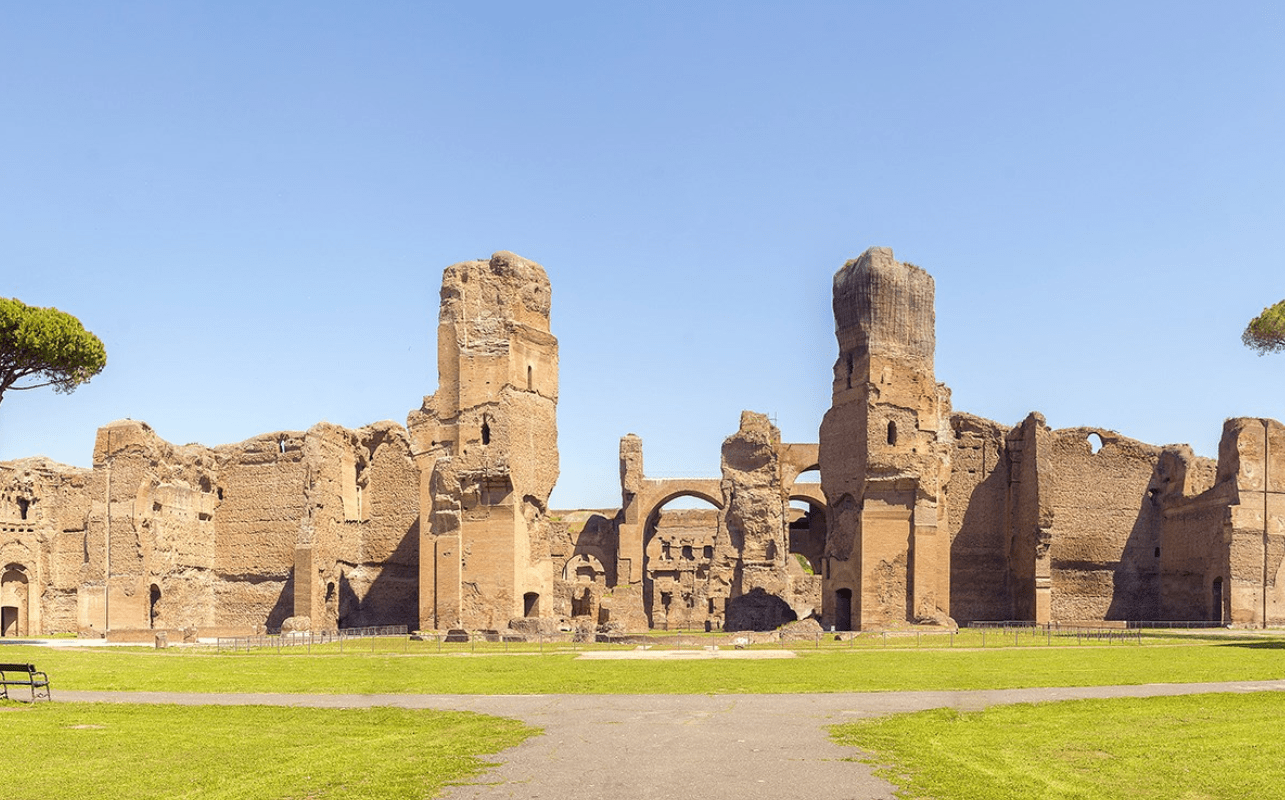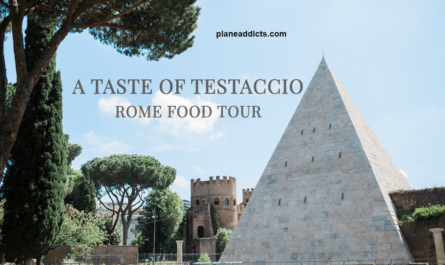The Baths of Caracalla: For anyone visiting Rome for the first time, the Colosseum is an essential stop. But how many people venture a little further south to explore the magnificent Baths of Caracalla? While not exactly a hidden gem, these ancient baths are a centuries-old marvel and one of Rome’s premier archaeological sites, often free of long lines.
Known as the Thermae of Caracalla, these Roman baths were constructed by Emperor Caracalla to showcase architectural splendor, style, and luxury. They were designed to offer a grand public spa experience, and today, during the summer months, they serve as a stunning venue for opera performances.
The thermal bath complex, standing 90 feet tall, could accommodate approximately 6,000 bathers at once and also functioned as a social hub. Exploring its impressive architecture and the effort behind its construction is a top highlight in Rome.
History of the Baths of Caracalla
Originally referred to as Thermae Antoninianae, the Baths of Caracalla were commissioned by Emperor Caracalla in 212 AD. The construction, which involved around 9,000 workers, took five years to complete, making it one of the largest and best-preserved thermal baths from ancient Rome. The baths opened in 216 AD and remained in operation until 537, when Gothic King Vitige cut off the water supply to seize the city.
Situated on the southern side of ancient Rome, the construction of the baths continued for a year after Caracalla’s death. The final emperors of the Severan dynasty, Heliogabalus and Alexander Severus, completed the exterior walls of the complex.
Before the baths, the area was developed by the Severan emperors, featuring the Via Nova and the Septizodium, a grand nymphaeum on Palatine Hill that framed the start of the Appian Way.
Water was supplied by a dedicated branch of the Aqua Marcia aqueduct, known as Nova Antoniniana. The remains of the massive water cisterns on the southern side are still visible today.
The baths were adorned with numerous statues, paintings, and mosaics.
Wellness Experience at the Baths of Caracalla
At its peak, the Baths of Caracalla featured the natatio, an Olympic-sized swimming pool that was heated throughout the year. The natatio’s northern facade was lined with enormous grey pillars, and statues were placed in niches along the walls, crafted from Caristio marble and Granito del Foro.
Visitors would begin their experience in the changing rooms and gym. After physical exercise, they would move to the laconium for a sauna session, followed by the calidarium, a warm room heated by a hypocaustum system that circulated hot air under the floor.
Next, bathers would visit the tepidarium to gradually lower their body temperature before entering the frigidarium, the coldest room with its extravagant triple cross vault.
The entire complex, laid out in a rectangular shape typical of imperial baths, was organized along a single axis to maximize sun exposure. The complex included symmetrical changing rooms and gyms to accommodate large numbers of bathers.
The northern side of the complex was dedicated to shops (tabernae), while the southern section housed two libraries, one of which remains visible.
Highlights Inside the Caracalla Baths
Calidarium, Tepidarium, and Frigidarium
A typical visit to the Baths of Caracalla began with a session in the gym, followed by a sauna. The spa experience included three key rooms:
- Calidarium: A warm room with an efficient heating system. It featured a large dome and wall niches with tubs.
- Tepidarium: A transitional space for cooling down before entering the frigidarium.
- Frigidarium: The cold room, notable for its basilica-like structure and inspiration for future buildings like the Baths of Diocletian and the Basilica of Maxentius.
The frigidarium served as a gathering area for visitors before exploring other parts of the baths. It featured cold baths connected to the natatio through waterfalls.
Decoration of the Baths of Caracalla
The Baths of Caracalla were also a visual feast. They featured elaborate decorations, including pillars, colorful marble mosaics, fine marble wall ornaments, and glass paste mosaics on the vaults. The baths were adorned with painted stuccoes and numerous statues, many in marble and some in bronze.
The floors of the upper level displayed marine mythological figures and creatures. Unfortunately, many artworks were looted during the Middle Ages, with pieces repurposed for churches and private collections.
Notable surviving artifacts include the Toro Farnese, a large marble sculpture now housed at the Museo Archeologico in Naples, and a column from the natatio in Piazza Santa Trinità in Florence. Many sculptures are part of private collections, while others can be seen in various museums and churches.
Exploring the Underground of the Baths of Caracalla
The underground area of the Baths of Caracalla is particularly intriguing. It features a network of tunnels used for transporting materials and housing the heating system. A significant discovery from the early 20th century was a Mithraeum, a sanctuary dedicated to the Persian god Mithra, the largest of its kind found in Rome.
The Baths of Caracalla Today
The Baths of Caracalla are not only a fascinating historical site but also host summer opera performances by Rome’s Teatro dell’Opera. Since 1937, the site has been used for cultural events, with performances by composers like Gaetano Donizetti and Giacomo Puccini. The summer opera season has expanded over the years, with performances now accommodating up to 20,000 spectators.
Best Tours of the Baths of Caracalla
While the site provides descriptive plaques, a guided tour can greatly enhance your visit. Archaeologists, historians, or expert guides offer insights into the daily life of ancient Romans and the complex’s grandeur.
You can choose between a one-hour tour of the Baths of Caracalla or a combined tour with the Circus Maximus, including skip-the-line access. These tours provide a deeper understanding of the baths’ history and significance.
Is the Baths of Caracalla Worth Visiting?
For history and archaeology enthusiasts, the Baths of Caracalla are a must-see. Despite their proximity to the Colosseum, they rarely have long queues, making it easier to explore their vast ruins and imagine their former splendor. The site includes various sections, from gardens and mosaics to libraries and pools, showcasing the architectural and engineering marvels of ancient Rome.
How Long Does It Take to Visit the Baths of Caracalla?
A typical visit to the Baths of Caracalla takes about an hour to an hour and a half. For those interested in a more detailed exploration, including the underground areas and intricate decorations, a visit may extend to two or two and a half hours.
Practical Information for Your Visit
Address: Viale delle Terme di Caracalla
How to Reach: Metro B (Circo Massimo stop) with a 10-minute walk; buses 160, 671, 714, 792
Opening Hours: Tuesday-Sunday, 10 am-7:15 pm (last entry at 6:30 pm); Closed on Mondays
Entrance Fee: €8 at the site, €10 online; €2 reduced ticket for EU citizens aged 18-25
Tips for Visiting the Baths of Caracalla
- Wear comfortable shoes: The site is large with many stairs.
- Bring water: Hydrate, especially during hot weather.
- Take your camera: Capture the stunning sights.
- Visit in cooler weather: Much of the site is open-air.
- Carry a shawl: For warmth in the humid underground areas.
Nearby Attractions
- Circus Maximus: About 800 meters away, with archaeological tours and 3D experiences.
- Villa Celimontana: A park with historic charm.
- Aventine Hill: Explore churches, the Garden of the Oranges, and ancient sites.
- Testaccio Neighborhood: Experience authentic Roman culture.
Where to Eat Near the Baths of Caracalla
- Osteria 22quattro (Via Vetulonia 52): Homemade dishes, 1 km away.
- Felice a Testaccio (Via di Mastro Giorgio 18): Renowned restaurant in the Testaccio area.
- Ristorante Romolo e Remo (Via Pannonia 22): Traditional Roman dishes, 10 minutes away.
- La Valle del Sacco (Via Bartolomeo Bossi 4): Creative Roman cuisine, 20 minutes away.



